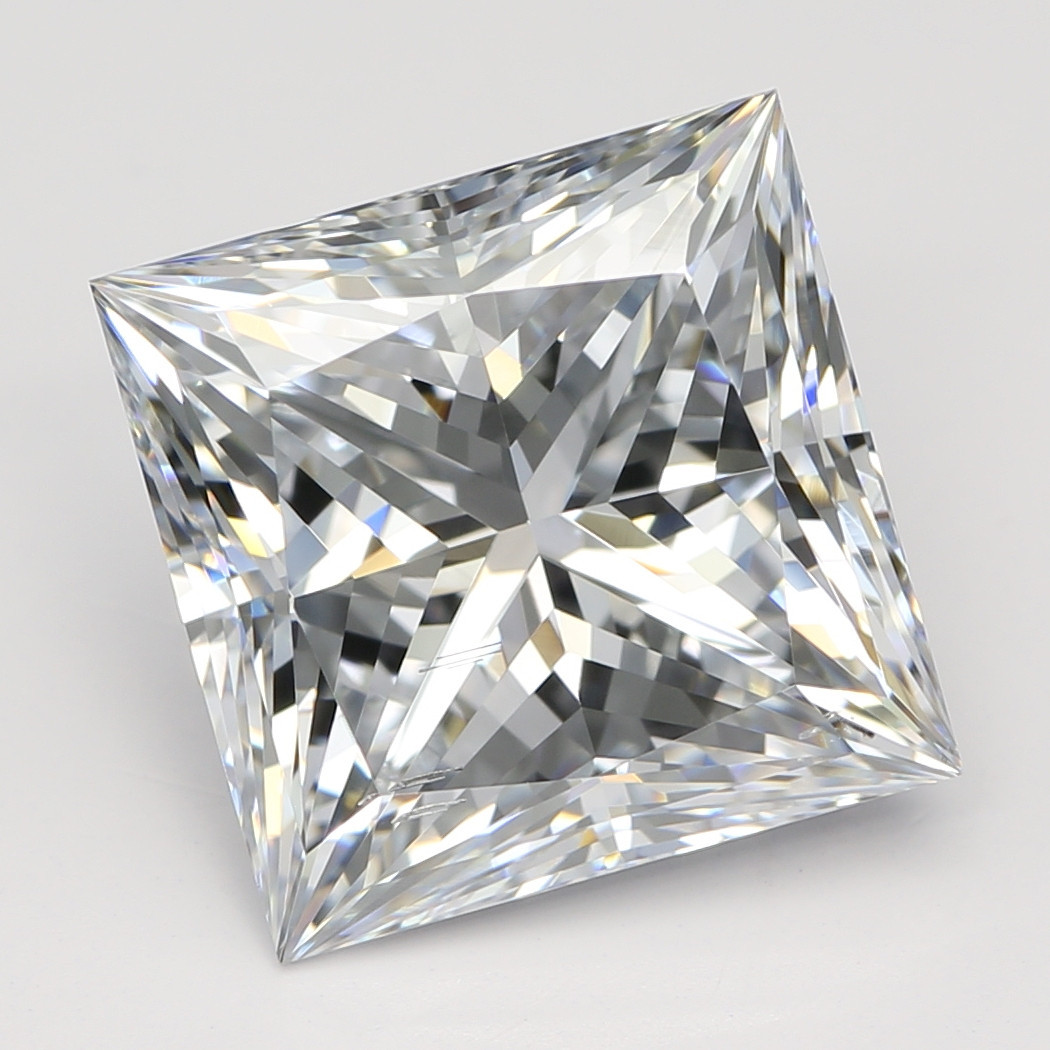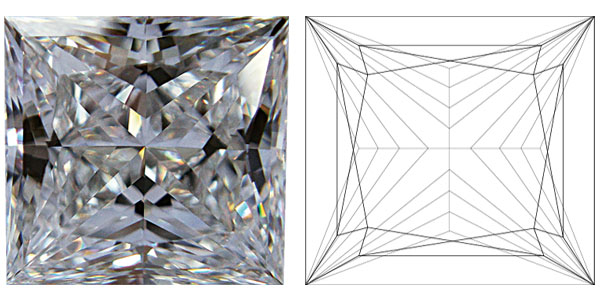
“Princess Cut Diamonds / Princess Cut:
Rough diamond shape, pyramid, X shape, snowflake design & Disney Princess -> nature, architecture & fairy tales inspired”
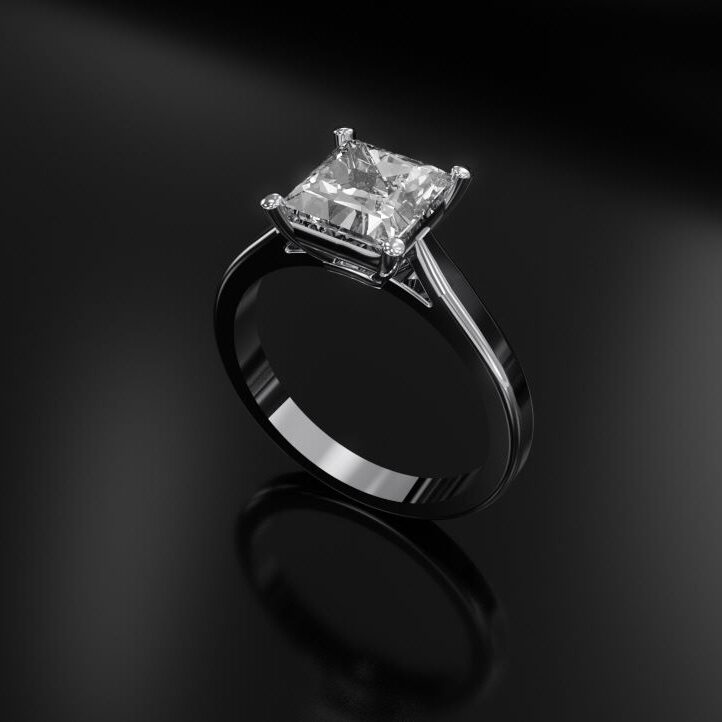
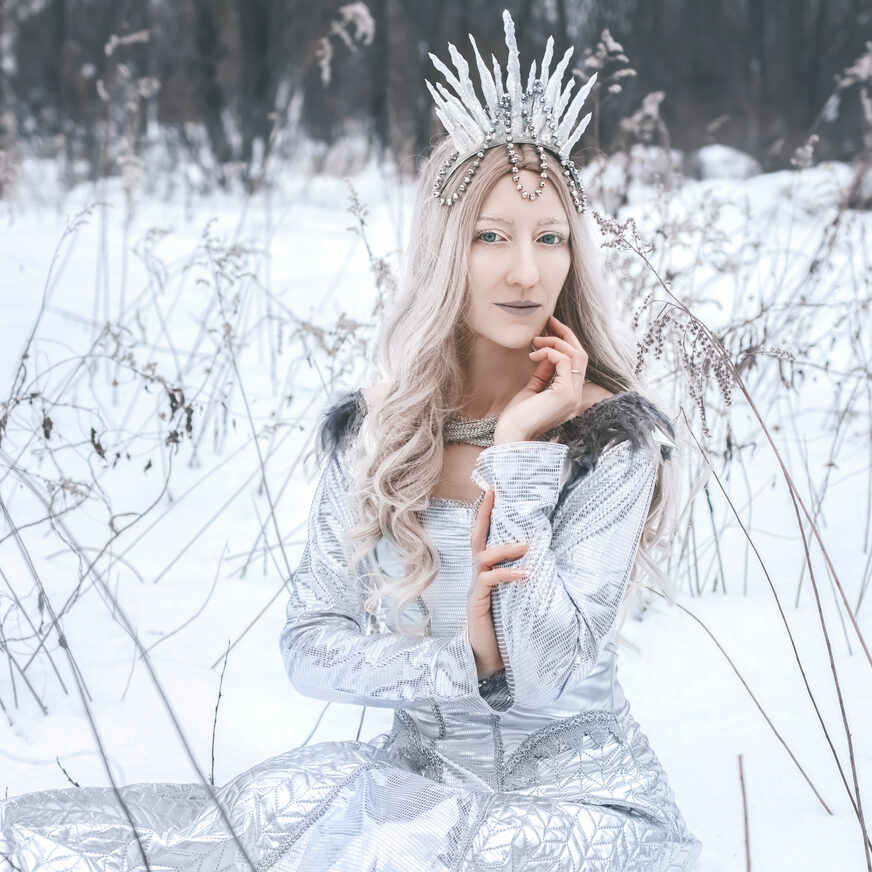
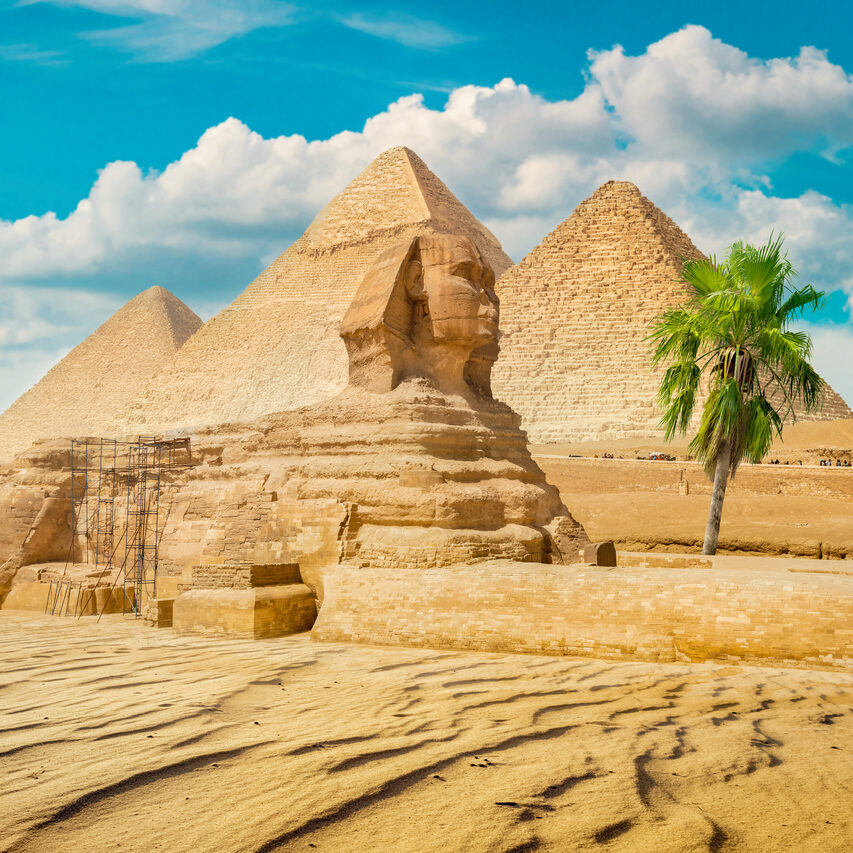
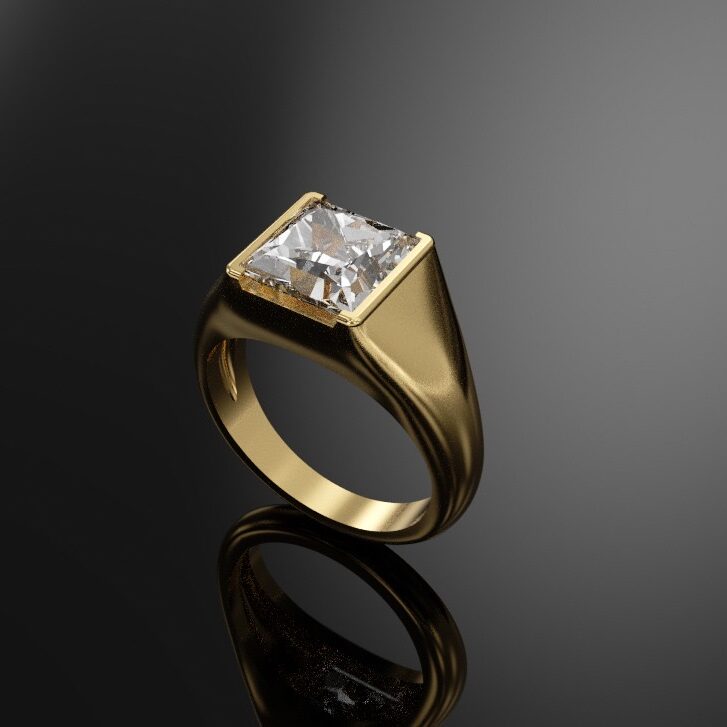
“Princess cut diamonds: Majestic brilliance, timeless elegance”
“Modern splendor, royal brilliance – your Princess Cut diamond, the perfect fusion of style and radiance”
What is a Princess Cut Diamond?
The princess cut diamond, also known as the square modified brilliant cut, is a popular diamond shape that is appreciated for its modern and elegant appearance. The cut is characterized by its square or rectangular shape and has numerous facets that give it a sparkling pattern of brilliance. The pointed corners of the Princess Cut give the diamond a striking and contemporary look.
Like an upside down pyramid, a princess cut diamond is square on top, four beveled sides, and tapers to a point under the ring’s shiny surface. A princess cut diamond is traditionally a square diamond with excellent fire and brilliance. The clean lines give this diamond cut a modern look. This cut is ideal if you want maximum sparkle in a modern design.
Immerse yourself in the fascinating world of the Princess Cut diamond – a masterpiece of elegance and brilliance. This unique cut combines the timeless beauty of a brilliant-cut diamond with a modern, angular shape that immediately catches the eye. The square or rectangular silhouette of the Princess Cut adds a touch of sophistication and timeless appeal to any piece of jewelry.
With its numerous facets, the Princess Cut shines with breathtaking brilliance, reflecting the light in all directions. The distinctive pointed corners give the diamond character and make it a perfect choice for those looking for a contemporary yet classic engagement ring or piece of jewelry.
Discover the beauty and brilliance of the Princess Cut diamond – a timeless choice that combines elegance and modernity.
Advantages Princess cut
What makes the princess cut so unique? What are the advantages of the princess cut?
- Modern & edgy look
technical designation = “square modified brilliant” → are brilliant cut
→ Princess cut enables a square outline and yet offers almost the same brilliance as the round diamond - Square (sometimes rectangular) shape with pointed corners and up to 76 small facets. The cut has a square or rectangular shape when viewed from above and resembles an inverted pyramid with four beveled sides when viewed from the side.
→ When you look down on it, it shows an X shape
→ This diamond replicates the snowflake design with class - Common in engagement rings (second most popular choice in 2015 at 30%, Round (50%) Cushion (8%)).
- Disney created a series of Disney Princess rings, some of which, like Aurora, Fa Mulan, Snow White and Tinker Bell, were princess cut
- Also very suitable and beautiful for men (geometric design & square diamond)
The princess cut is a very popular diamond shape and gives diamond jewelry a modern, edgy look.
The princess cut diamond offers a number of advantages that make it a popular choice for engagement rings and other jewelry:
- Brilliance and sparkle: Princess Cut diamonds are characterized by their brilliant light reflection and impressive sparkle. The many facets of the princess cut allow a high level of light refraction, resulting in a vibrant and sparkling appearance.
- Modern aesthetics: The square or rectangular cut of the princess cut gives the diamond a modern and contemporary aesthetic. This clear geometric shape is popular with people who appreciate clean lines and symmetry.
- Versatility: Princess Cut diamonds are extremely versatile and go well with different ring designs and jewelry styles. Whether as a solitaire or embedded in pavé or channel settings, this cut can be implemented in various creative designs.
- Efficient use of the rough diamond: The Princess cut is designed to utilize as much material as possible from the rough diamond, resulting in less waste. This makes it more efficient in the use of rough diamonds compared to some other cuts.
- Elegant appearance: The clear and geometric shape of the princess cut gives the diamond an elegant and sophisticated appearance. This makes it a popular choice for engagement rings where elegance and modernity are paramount.
- Popular choice for engagement rings: Princess cut diamonds are a frequently chosen shape for engagement rings as they are a modern yet timeless option. The clear lines and impressive sparkle make them a romantic and eye-catching symbol of love.
Overall, the Princess Cut diamond offers a successful combination of contemporary elegance, versatility and impressive sparkle, making it a desirable choice for jewelry lovers.
Disadvantages Princess cut
Recommendation for princess diamonds: What should you look out for when buying a princess cut diamond? What are the disadvantages of the princess cut?
Although the princess cut diamond is popular due to its brilliance and modern shape, it also has some potential drawbacks:
- Sensitivity to corners and edges: The sharp corners of the Princess Cut make it more susceptible to chipping and damage compared to round brilliant cut diamonds, which have no sharp edges. A professional setting and regular care are important to minimize this disadvantage.
- Corner protection: Due to the sharp corners, adequate protection is important to prevent damage. Choosing a suitable ring design that protects the corners is therefore crucial.
- Visible inclusions: Due to the specific type of cut, inclusions and impurities may be more easily visible in the diamond. This may necessitate the selection of a higher clarity rating, which could affect the price.
- Price: Princess cut diamonds can be more expensive than other cuts. In addition, the elaborate cut requires more time and precision, which can also be reflected in the price.
- Preference for high quality and material: Princess cut diamonds can tend to show the color of the stone a little more. Therefore, some buyers prefer diamonds with higher color qualities, which can further influence the price.
It is important to consider these potential drawbacks when choosing a princess cut diamond and carefully weigh up the pros and cons to make the best decision for your own preferences and needs.
Stars
Which stars and celebrities have a princess cut diamond engagement ring?
Some celebrities who wear an engagement ring with a princess cut diamond are:
- Kate Bosworth: Her engagement ring by Michael Polish features a princess-cut diamond.
- Hilary Duff: Hilary Duff’s engagement ring, gifted by Matthew Koma, features a beautiful princess-cut diamond.
- Eva Longoria: In addition to her cushion-cut ring, Eva Longoria also wore an engagement ring with a princess-cut diamond.
Sparkle
Do princess cut diamonds sparkle the same as round brilliant cut diamonds?
Princess cuts can have exceptional brilliance. Nevertheless, they do not come close to the brilliance of round diamonds. No fancy cut can match their optimum light output. So while princess cuts can have great sparkle, they will never sparkle better than an ideal round diamond.
Size
Should I use more carats in a princess cut diamond?
If you compare a princess diamond and a round diamond with the same carat weight, you will see that the round has a slightly larger area upwards. However, princess cuts can often appear larger because they have such large diagonal dimensions.
Longevity
Are Princess Cut Diamonds Durable? Are princess cut diamonds fragile or easily broken?
Since the corners of a princess cut diamond can get caught, there is a risk of chipping. Their corners should always be protected with prongs to reduce the risk of damaging the stone.
Engagement Ring Styles for Princess Cut Diamonds
Are princess cut diamonds suitable for an engagement ring?
Of course, you can’t consider different diamond shapes without considering style! Although round diamonds are a classic standard shape, princess cut diamonds are the most popular shape. They pair well with many styles, including solitaire and three-stone engagement rings.
The brilliance and geometric shape of the princess cut make them a great choice for elegant, modern styles.
Cut
What should I look for in a princess cut diamond?
The sparkle of a diamond comes mainly from the quality of its cut. Unfortunately, you will find that evaluating a princess cut is a bit more difficult than evaluating a round one. Most gemological certification companies do not evaluate the cut quality of fancy cuts, including princesses.
All fancy cut diamonds have too many variations for standardized cut grades. Unlike the round brilliant, there is no set expectation of what a princess cut should look like. Princess cuts can differ in both the pattern on the crown and the number of cuts on the pavilion. While neither will impact value or quality, you will simply prefer one over the other.
Socket: thickness of border
Because of the fragile corners, make sure the bezel setting is thick enough to support the prongs. While most princess rondels support prongs, “extremely thin” rondels make the diamond more prone to breakage.
Color
What should be the minimum color of a princess cut diamond?
Princess-cut diamonds, as well as other fancy shapes, show more color than a round diamond. Although there is a slight color difference, it is difficult to notice unless you look at the diamonds side by side.
The color quality of a princess cut diamond is an important factor in the selection process. Most experts recommend a diamond in the D to G range for a princess cut to ensure an optimal balance between colorlessness and value.
Here is a brief explanation of the color grades:
- D-F (Colorless): Diamonds in this range are colorless and very rare. They reflect most of the light and appear particularly white.
- G-H (almost colorless): These diamonds have minimal color tones that are often difficult for the naked eye to see. They are a popular choice for engagement rings.
With a princess cut, which has many facets, color tones can be hidden somewhat better than with some other cuts. This allows you to choose color quality more flexibly while still maintaining a beautiful, sparkling appearance. However, it is important to note that the color rating also depends on the wearer’s personal taste and preferences. Some people prefer diamonds with a hint of color, while others prefer a colorless appearance.
For princess cut diamonds set in either white gold or platinum, we recommend an H color diamond or better. With rose gold and yellow gold rings, a J color diamond looks great and saves you some money!
Clarity
What should be the minimum clarity of a princess cut diamond?
A clarity in the range of VVS2 (very, very small inclusions) to VS2 (very small inclusions) is often recommended for princess cut diamonds. Here is a brief explanation of these purity grades:
- VVS (Very, Very Small Inclusions): Diamonds in this category have tiny inclusions that are very difficult to see even under 10x magnification.
- VS (Very Small Inclusions): Diamonds in this category also only have very small inclusions that are difficult to recognize, even under 10x magnification.
The princess cut diamond, with its many facets, can tend to hide inclusions better than some other cuts. Therefore, you can be flexible with a slightly lower clarity grade while still getting a clear and sparkling diamond.
The choice of purity also depends on individual preferences. Some people prefer diamonds with minimal inclusions, while others are happy with smaller inclusions as long as they are not visible to the naked eye.
Ideal Mass Princess, Princess
What are the perfect measurements for a princess cut diamond? What dimensions should a princess cut diamond have in terms of depth and table? What is the ideal length ratio for a princess cut?
- Length-to-width ratio: Approximately 1.0 to 1.05 (minimum 1.0).
Length-to-Width For a square princess cut 1.05 and below - Depth %: Between 65% and 75%
- Table %: Between 65% and 75%. A small minority of diamond dealers prefer princess cuts with a very small table, under 68%.
- Girdle (round bar): The girdle, or round bar, should be in the thin to medium range to ensure optimum durability and esthetics. Care must be taken not to make it too thin in order to minimize the risk of chipping on the fragile, sharp corners of the princess cut diamond. This gives the Princess Cut diamond a balanced appearance.
- Sharp tips (more susceptible to damage) -> well protected in socket
The ideal dimensions for a princess cut diamond can vary, as personal preferences and aesthetic preferences play a role. However, there are general recommendations that can serve as a guideline.
For a classic princess cut diamond, the ideal length-to-width ratio is around 1.0 to 1.05. This means that the length of the diamond is approximately equal to the width or can be slightly longer.
The depth of the diamond is also an important factor. An ideal ratio of depth to width is often between 65% and 75%. This depth contributes to the diamond reflecting optimal light and offering a sparkling appearance.
However, it is important to note that individual preferences play a decisive role in choosing the ideal proportions. Some people may like slightly rectangular princess cut diamonds, while others prefer an almost square shape. The best proportions are therefore often subjective and depend on the wearer’s preferences.
These proportions offer a good balance between brilliance, light reflection and aesthetic appearance for a princess cut diamond. However, it is important to note that personal preferences and individual aesthetics can play a major role in choosing the ideal proportions.
Budget Tips Princess
How can I save money on a Princess Cut Diamond?
If you stick to the VS purity grade, you will receive a beautiful princess cut at an attractive price. In white gold settings, an H or I color diamond will still look white. In yellow or rose gold, a J color princess cut can still look great!
history
When was the princess cut diamond invented? What is the history, the history of Princess Cut diamonds?
The princess cut evolved from the French cut, which evolved from the table cut that emerged in the 14th century. Over time, cutters became more adept at the ratio of facet placement and the angles of one facet to another on a diamond. There is some debate as to when the term Princess Cut diamonds began to be used. Some diamond historians believe it began in the 1960s. In the 1980s, diamond lovers were enthusiastic about the princess cut diamond.
A diamond cut from centuries past
Some of the most style conscious collectors opt for square cut diamonds. The luxurious square diamond shape has some serious historical roots dating back to the 14th century. Its popularity lies in its particular facet diagram (the cut pattern), which helps the stone reflect light back to the eye. Plus, it has clean, straight lines that keep it looking fresh and on trend, no matter how old or new it is.
First it was a French cut
It is believed that the first cutters who created square diamonds did so because they wanted to optimize the rough diamond crystals, which often had the shape of an octahedron (= growth form of mine diamonds). Think of the octahedron as two pyramids joined at their flat bottoms. When they cut square shapes from the octahedron, much less diamond was cut away, so the resulting stone had a much greater carat weight. That’s a good thing. For centuries, this primitive square cut was preferred, and by the early 20th century, it was known as the French Cut diamond. The hallmark of a good French cut diamond is that it retains much of its original rough shape, yet produces stones with spectacular light return – which is a jazzy way of expressing its “sparkle”. It was such a brilliant way to cut and polish diamonds that cutters used the same pattern to cut sapphires, rubies, and emeralds, which were the main colored stones at the time. If you think of the Art Deco period that developed in the 1920s, you may remember that many fashionable gems were cut into square shapes – diamonds and colored gemstones alike. This is because the Art Deco era paid homage to the glorious industrial age and the architectural achievements of that time. So there was a geometric aspect to fine diamond and gemstone jewelry.
Princess cut diamond is also very suitable and beautiful for men
Is a princess cut diamond also suitable for men?
It’s also a great shape for men. The geometric design of square diamonds is suitable for a sophisticated men’s ring.
Absolutely, the Princess Cut Diamond is a versatile and elegant choice that is quite appealing for men’s jewelry. Although the princess cut is often associated with feminine jewelry such as engagement rings, it can also be used in various other types of men’s jewelry, including wedding rings, cufflinks or necklaces.
The square cut of the Princess Cut diamond gives the stone a modern and clear aesthetic. The clear lines and multi-faceted structure accentuate the brilliance and shine of the diamond. Men who prefer a striking yet sophisticated style will find the Princess Cut an appealing option.
It is important to note that personal taste and style preferences play a decisive role in the selection of diamond jewelry. A princess cut diamond can be a timeless and striking choice for men looking for a touch of luxury and sophistication.
PRINCESS (Square Modified Brilliant)
Like any other industry, diamond trading is a business of innovation and evolution. As the cutting processes became more complex and knowledge of a diamond’s light behavior became better understood, each diamond shape changed, decade after decade. The square cut diamond also evolved into what was known in the industry as the square modified brilliant cut. We see that this definition of a square diamond shape first appeared in the early 1960s. The cut pattern was different from its previous incarnation as a French Cut. Cutters got smarter about the relationship of facet placement and the angles of one facet to another on a diamond. All of this helped produce diamonds that were more brilliant than their earlier counterparts. There is some debate as to when the term “princess cut” diamonds was first used. Some diamond historians believe it began in the 1960s. But definitely in the 1980s, diamond lovers embraced the princess cut diamond with gusto.
